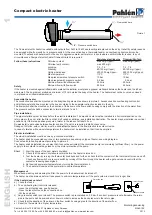
8
2. Unconfined Space
3. Confined Space
The information on the followed pages will help you classify your space and provide adequate ventilation.
Confined and Unconfined Space
The National Fuel Gas Code, ANSI Z223 .1/NFPA 54 defines a confined space as a space whose volume
is less than 50 cu. ft. per 1,000 BTU/hr (4.8 m
3
per kw) of the aggregate input rating of all appliances
installed in that space and an unconfined space as a space whose volume is not less than 50 cubic feet
per 1,000 BTU/hr (4.8 m
3
per kw) of the aggregate input rating of all appliances installed in that space.
Rooms connecting directly with the space in which the appliances are installed, through openings not
furnished with doors, are considered a part of the unconfined space.
This heater shall not be installed in a confined space or unusually tight construction unless provisions are
provided for adequate combustion and ventilation air. Adjoining rooms are connecting only if there are
odorless passageways or ventilation grills between them.
Unusually Tight Construction
The air that leaks around doors and windows may provide enough fresh air for combustion and ventilation.
However, in buildings of unusually tight construction, you must provide additional fresh air. Unusually
tight construction is defined as construction where:
a) Walls and ceilings exposed to the outside atmosphere have a continuous water vapor retarder with a
rating of one perm (6×10-11kg per pa-sec-m
2
) or less with openings gasket or sealed and
b) Weather stripping has been added on openable windows and on doors and
c) Caulking or sealants are applied to areas such as joints around window and door frames, between sole
plates and floors, between wall ceiling joints, between wall panels, at penetrations for plumbing, electrical,
and gas lines, and at other openings.
If your home meets all of the three criteria above, you must provide additional fresh air. See “Ventilation
Air From Outdoors”. If your home does not meet all of the three criteria above, proceed to “Determining
Fresh-Air Flow For Heater Location”.
6. DETERMINING FRESH-AIR FLOW FOR HEATER LOCATION
Using this worksheet to determine if you have a confined or unconfined space. Space: Includes the room
in which you will install heater plus any adjoining rooms with doorless passageways or ventilation grills
between the rooms.
1. Determine the volume of the space Length × Width × Height = cu. ft. (volume of space)
Example: Space size 20 ft. (length) × 16 ft. (width)×8 ft. (ceiling height) =2560 cu. ft. (volume of space) If
additional ventilation to adjoining room is supplied with grills or openings, add the volume of these rooms
to the total volume of the space.
2. Divide the space volume by 50 cubic feet to determine the maximum BTU/hr the space can support.
(volume of space) ÷ 50 cu. ft. =(Maximum BTU/hr the space can support)
Summary of Contents for WLT060-VF
Page 22: ...ILLU USTRATE ED PARTS S Models s WDFT0 22 060 VF IR R...
Page 24: ...ILLU USTRATE ED PARTS S Model WDFT10 24 00 VF IR...
Page 26: ...ILLU USTRATE ED PARTS S Model WDFT25 26 50 VF IR...
Page 28: ...ILLU USTRATE ED PARTS S Models s WNT06 28 60 VF IR W WLT060 VF IR...
Page 30: ...ILLU USTRATE ED PARTS S Models s WNT10 30 00 VF IR W WLT100 VF IR...
Page 32: ...ILLU USTRATE ED PARTS S Models s WNT25 32 50 VF IR W WLT250 VF IR...









































